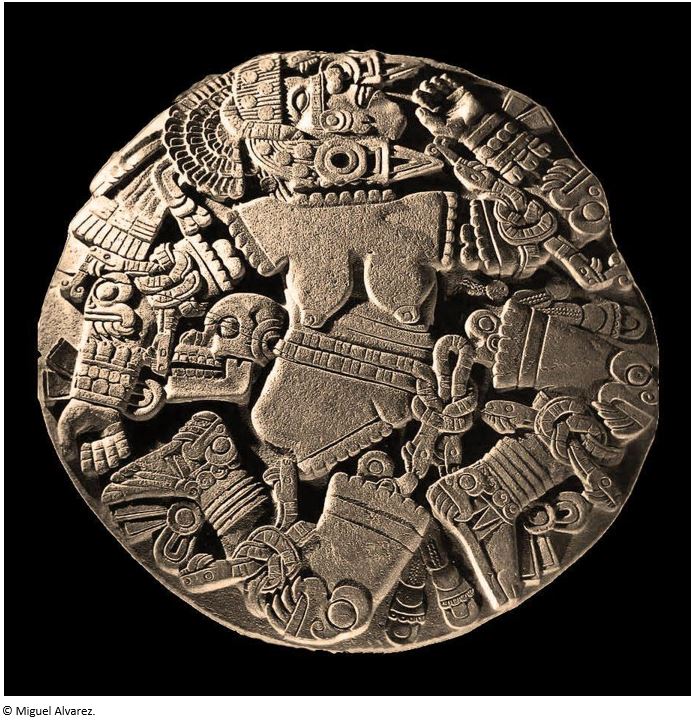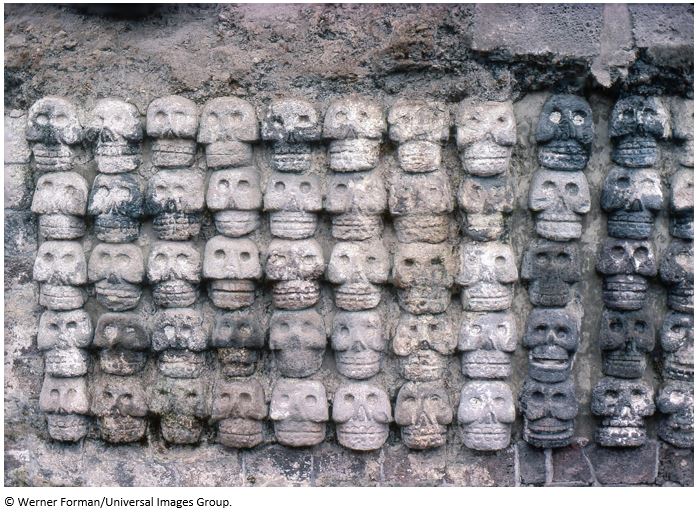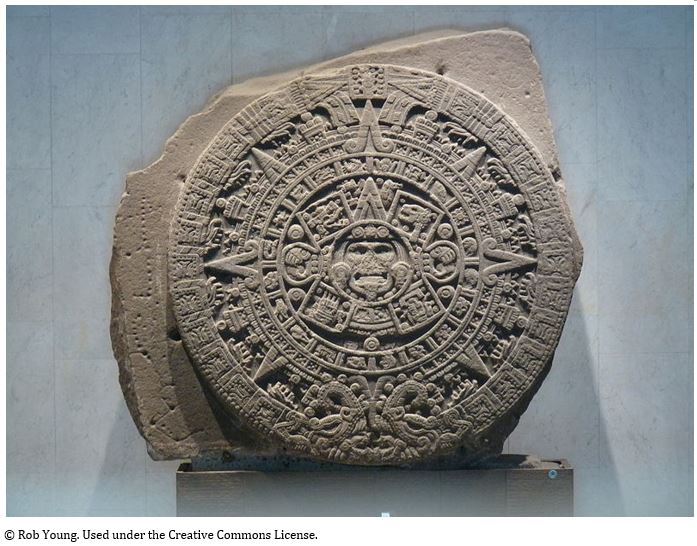9th Grade Aztec Inquiry
What Do the Buried Secrets of Tenochtitlán Tell Us About the Aztecs?
Download the Inquiry Here
What Do the Buried Secrets of Tenochtitlán Tell Us About the Aztecs?
Download the Inquiry Here
Staging the Compelling Question:
- Source A found in PDF/DOC- Photographs of the excavation of Tenochtitlán from the newspaper article “Mexico City’s Aztec Past Reaches Out to Present,” New York Times, September 2, 2012
- Source B found in PDF/DOC- Elisabeth Malkin and Sofia Castello y Tickell, newspaper article describing the challenges of uncovering how past societies lived, “Mexico City’s Aztec Past Reaches Out to Present,” New York Times, September 2, 2012
Supporting Question 1- Where was Tenochtitlán?
Depending on students’ familiarity with reading and analyzing maps, teachers may organize this exercise in different ways. The graphic organizer, Mapping Tenochtitlán, included within the inquiry focuses students on two major points of analysis: (1) key features of the map and (2) how the map helps in answering the supporting
question, “Where is Tenochtitlán?” For students who need additional scaffolding, teachers may want to do direct teaching about the key features of a map. For example, teachers could discuss the following features to help anchor students’ analysis: title, orientation, scale, legend, and grid. Teachers might also use the following map analysis worksheet by the National Archives as guided practice for Map A and/or B: http://www.archives.gov/education/
lessons/worksheets/map_analysis_worksheet.pdf. As students demonstrate proficiency in reading a map, they could work through the rest of the collection independently or in small groups
Depending on students’ familiarity with reading and analyzing maps, teachers may organize this exercise in different ways. The graphic organizer, Mapping Tenochtitlán, included within the inquiry focuses students on two major points of analysis: (1) key features of the map and (2) how the map helps in answering the supporting
question, “Where is Tenochtitlán?” For students who need additional scaffolding, teachers may want to do direct teaching about the key features of a map. For example, teachers could discuss the following features to help anchor students’ analysis: title, orientation, scale, legend, and grid. Teachers might also use the following map analysis worksheet by the National Archives as guided practice for Map A and/or B: http://www.archives.gov/education/
lessons/worksheets/map_analysis_worksheet.pdf. As students demonstrate proficiency in reading a map, they could work through the rest of the collection independently or in small groups
- Source A found in PDF/DOC- Image bank: Maps of the Aztec Empire and Tenochtitlán.
Three additional resources are included within this section as a reference and for additional student exploration. All three articles are from a 1980 special issue of National Geographic that focused on the Aztecs and, more specifically, the excavation of Tenochtitlán.
- Eduardo Matos Moctezuma and David Hiser, “New Finds in the Great Temple.” National Geographic, December 1980.
- Bart McDowell, David Hiser, and Felipe Dávalos. “The Aztecs.” National Geographic, December 1980.
- Augusto F. Molina Montes and Felipe Dávalos, “The Building of Tenochtitlan.” National Geographic, December 1980.
- map analysis worksheet by the National Archives as guided practice for Map A and/or B: http://www.archives.gov/education/
lessons/worksheets/map_analysis_worksheet.pdf - Additional images of Tenochtitlán can be found at the Foundation for the Advancement of Mesoamerican Studies website in “The Aztecs: Tenochtitlán” found on John Pohl’s Mesoamerica section: http://www.famsi.org/research/
- pohl/pohl_aztec2.html
Supporting Question 2- What do three archeological artifacts tell us about the Templo Mayor?



- Exhibition cards and photos of the artifacts are available in the Inquiry Guide.
- For students wanting to do additional research on the three artifacts, the following two sources will shed additional light on the Aztec practice of human sacrifice and details on the Aztec calendar. John M. Ingham, “Human Sacrifice at Tenochtitlan,” Comparative Studies in Society and History 15 (1984): 379–400. http://www.latinamericanstudies.org/aztecs/aztec_human_sacrifice.pdf. (Teachers are recommended to use excerpts from this piece to shed light on reasons for human sacrifice.)
- Teachers wanting students to do a closer read of these objects might use the Smithsonian’s guide to reading objects, Engaging Students with Primary Sources (pp. 48–51): http://historyexplorer.si.edu/primarysources.pdf.
Supporting Question 3- How did Tenochtitlán sustain itself?
- Source A: Hernán Cortés, descriptions of Tenochtitlán, second letter to Charles V (excerpt), 1520 The Bodleian Libraries, The University of Oxford. Shelfmark: MS. Arch. Selden. A. 1, fol. 20r
- Source B: Codex Mendoza, an annotated manuscript describing the Aztec tribute system, ca. 1535
The Bodleian Libraries, The University of Oxford. Shelfmark: MS. Arch. Selden. A. 1, fol. 20r.
- Source C: Te Papa, Photograph of a model of Aztec chinampas
Supporting Question 4- How was Tenochtitlán buried?
- Source A: Jared Diamond, book that analyzes the impact of disease on social change, Guns, Germs, and Steel (excerpt), 1999 Reprinted from Jared Diamond, Guns, Germs, and Steel. New York, NY: W. W. Norton, 1999: p. 210
- Source B: David Carrasco with Scott Sessions, analysis of the fall of the Aztec Empire, Daily Life of the Aztecs: People of the Sun and Earth (excerpt), 1998 Reprinted from David Carrasco, with Scott Sessions, Daily Life of the Aztecs: People of the Sun and Earth. Indianapolis, IN: Hackett Publishing, 2008: p. 226
Appendix B: Additional Sources for Teaching this Inquiry
Books
- David Carrasco, Daily Lives of the Aztecs: People of the Sun and Earth. Westport, CT: Greenwood Press, 1998: Provides historical content about the Aztecs and the building of Tenochtitlán.
- Michael D. Coe and Rex Koontz. Mexico: From the Olmecs to the Aztecs. New York, NY: Thames and Hudson, 2003: Guide to Tenochtitlán and the Spanish encounter.
- Jared M. Diamond, Guns, Germs, and Steel: The Fate of Human Societies.” New York, NY: Norton, 1999: Examines the tribute network and collapse of the empire.
- Migual Leon-Portilla, ed. Broken Spears: The Aztec Account of the Conquest of Mexico, new expanded edition. Boston, MA: Beacon Press, 2006: Highlights voices of indigenous people.
- James Lockhart and Stuart B. Schwartz. Early Latin America: A History of Colonial Spanish America and Brazil. Cambridge, UK: Cambridge University Press, 1983: Provides a general history of Latin America in the period between the European conquest and the gaining of independence by the Spanish American countries and Brazil (approximately 1492–1825)
Article
- Linda Levstik. “Teaching History by Connecting Human Intelligence, Innovation and Agency,” February 13, 2014. EduTopia website. http://www.edutopia.org/blog/teaching-history-intelligence-innovation-agency-linda-levstik: Provides guidance on working with students to develop chaîne opératoires.
- Silverio A. Barroqueiro, “The Aztecs: A Pre-Columbian History,” 1999, Yale-New Haven Teachers Institute website. http://yale.edu/ynhti/curriculum/units/1999/2/99.02.01.x.html: Overview of Aztec society
- Thayer Watkins, “The History of the Aztecs,” San Jose State University website. http://www.sjsu.edu/
faculty/watkins/aztecs.htm: Examination of economic and social aspects of Aztecs. - National Museum of the American Indian website. http://www.nmai.si.edu: Access to artifacts that were found at Templo Mayor in Tenochtitlán.